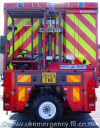BU04 FMG A West Midlands Fire Service Vauxhall Combo …

BU04 FMG A West Midlands Fire Service Vauxhall Combo 1.7DI. Both rear doors display the two emergency telephone numbers for the UK: 999 and 112. ‘112’ was adopted in the 1990s to be the single emergency number that could be used in all European Union countries. It makes no difference which one you dial.











































